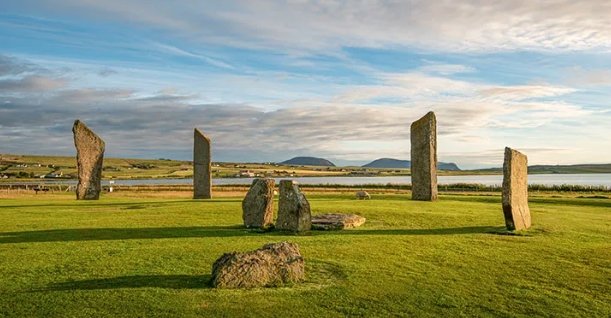Tucked away on the Orkney Islands, long before the pyramids and far from the crowds at Stonehenge, stand the quiet, wind-beaten Stones of Stenness—arguably the oldest stone circle in Britain.
At around 5,000 years old, these towering monoliths are thought to predate Stonehenge by several centuries, reshaping how we see the Neolithic past—not as a southern English affair, but as a deeply northern one too.
Ancient Stones, Modern Attention
You’d be forgiven for not knowing about the Stones of Stenness. They don’t make front pages. They’re not plastered across postcards. And they certainly don’t draw in the busloads of tourists that descend on Wiltshire every summer solstice.
But maybe they should.
Located in the heart of Neolithic Orkney, a UNESCO World Heritage Site, the Stenness circle forms part of a sacred landscape that includes the Ring of Brodgar, Maeshowe chambered cairn, and Skara Brae, the famous Neolithic village uncovered by a storm in 1850.
According to Historic Environment Scotland (HES), the Stones of Stenness once stood as 12 mighty megaliths arranged around a central hearth, encircled by a ditch and earthen bank. Today, only four stones remain upright—weathered, stoic, and somehow still commanding.

5,000 Years of Mystery and Ceremony
Unlike Stonehenge, where debates rage over celestial alignments and burial sites, Stenness wears its mysteries a little looser.
No one really knows what it was used for.
There’s no formal inscription. No tombs. Just massive standing stones—up to 6 metres tall—planted deep in Orkney’s peaty earth.
Still, archaeologists have pieced together theories. HES suggests the stones formed part of ritual ceremonies, likely related to the changing of seasons, or rites connecting the living and dead.
And while we’ll probably never get a definitive answer, that sense of mystery might be the point.
One sentence is enough: they weren’t built to be understood—they were built to be felt.
How Does Stenness Stack Up Against Stonehenge?
Let’s compare them, because people always do.
| Feature | Stones of Stenness | Stonehenge |
|---|---|---|
| Location | Orkney, Scotland | Wiltshire, England |
| Age | ~3,100 BCE | ~2,500 BCE |
| Original Stones | 12 | ~80 (at peak) |
| Current Upright Stones | 4 | Many intact |
| Purpose | Ritual, ceremonial (assumed) | Burial, solar alignments, rituals |
| Tourists per year | ~30,000 (est.) | 1.6 million (pre-COVID) |
| World Heritage? | Yes | Yes |
It’s not a competition—but if it were, Stenness would be the quiet heavyweight in the corner. Less polished. More raw. And older.
From Forgotten Field to Cultural Powerhouse
For centuries, these stones were left unprotected. Locals grazed sheep around them. Some stones were knocked over or repurposed. One was even broken up for building material in the 19th century before local historians stepped in.
It wasn’t until the late 20th century that they began to get serious recognition. UNESCO’s designation of the Heart of Neolithic Orkney in 1999 put the area on the global archaeological map.
Today, local guides, conservationists, and researchers are helping people reconnect with the site—not as a static ruin, but as a living piece of cultural memory.
And they’ve got a quiet mission: to give Stenness the spotlight it deserves.
A Trip to Stenness Feels Less Like a Tour, More Like a Time Shift
Ask anyone who’s been, and the first thing they’ll tell you is how quiet it is.
You don’t jostle for selfies. There are no barriers or ticket queues. Just a wide, open plain where the wind whistles and the sea glints in the distance.
One visitor described it as “standing inside a thought that someone had 5,000 years ago.”
And that’s the kind of experience you don’t get with rope lines and visitor centres.
Here’s what makes Stenness special for travellers:
-
You can walk among the stones—no ropes or guards
-
The circle lies close to other Neolithic sites, ideal for day tours
-
The landscape feels untouched, rugged, real
-
Winter light and long summer nights give it a surreal glow
If you time it right, you might even be the only person there.
Still Standing, Still Sacred
There’s a reverence to the Stones of Stenness that defies explanation. They’re not flashy. There’s no elaborate engineering or intricate carvings. Just stone and silence.
But maybe that’s the power.
In a time where noise and novelty often define what gets noticed, these stones have endured by doing nothing at all—except standing still.
They’ve stood through the Bronze Age, the Vikings, the Reformation, and the oil boom. Through climate shifts, crop cycles, and pandemics.
And now, slowly, they’re being seen again.


















